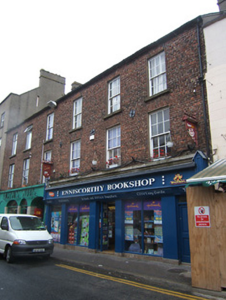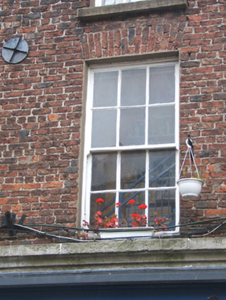Survey Data
Reg No
15603051
Rating
Regional
Categories of Special Interest
Architectural
Original Use
House
In Use As
House
Date
1790 - 1810
Coordinates
297218, 139727
Date Recorded
13/06/2005
Date Updated
--/--/--
Description
Terraced four-bay three-storey red brick house, c.1800. Renovated with replacement shopfront inserted to ground floor. One of a group of two. Pitched (shared) slate roof with clay ridge tiles, rendered (shared) chimney stacks having stringcourses, stepped capping, rendered coping, and cast-iron rainwater goods on red brick eaves having iron ties. Red brick Common (fifth course header) bond walls with cast-iron tie plates to top floor. Square-headed window openings with cut-granite sills forming part of stepped sill course to first floor, red brick voussoirs, and six-over-six timber sash windows. Replacement timber shopfront to ground floor with fluted pilasters, fixed-pane (two-light) timber windows, glazed timber door having sidelight, timber panelled door to house having overlight, fascia having gabled panelled consoles, and lined cornice. Interior retaining timber panelled reveals or shutters to some window openings. Street fronted with concrete brick cobbled footpath to front.
Appraisal
An appealing house built as one of a group of two houses (with 15603052) representing an important element of the late eighteenth- or early nineteenth-century architectural legacy of Enniscorthy. Exhibiting attributes indicating a patronage shared with a contemporary (1790) development in Mary Street (see 15603128 - 129) associated with the Sparrow family of nearby Blackstoops House, the house is distinguished in Rafter Street by the construction in red brick, the uniform Classical proportions on each floor lending a dignified, if understated quality to the composition, and so on. However, while the elementary characteristics prevail together with most of the original fabric, both to the exterior and to the interior, the external expression of the house at street level has not benefited from the introduction of a replacement shopfront of minimal design interest eradicating the original co-called 'Enniscorthy shopfront'.



